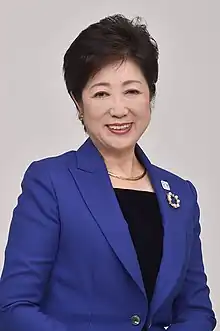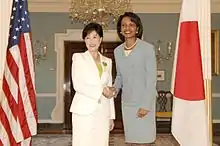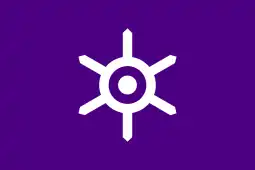Yuriko Koike | |
|---|---|
小池 百合子 | |
 Official portrait, c. 2017 | |
| Governor of Tokyo | |
| Assumed office 1 August 2016 | |
| Deputy | Mitsuchika Tarao Hiroshi Kajihara Kei Takechi Manabu Miyasaka |
| Preceded by | Yōichi Masuzoe |
| Minister of Defense | |
| In office 4 July 2007 – 27 August 2007 | |
| Prime Minister | Shinzō Abe |
| Preceded by | Fumio Kyūma |
| Succeeded by | Masahiko Kōmura |
| Minister of State for Okinawa and Northern Territories Affairs | |
| In office 27 September 2004 – 26 September 2006 | |
| Prime Minister | Junichirō Koizumi |
| Preceded by | Toshimitsu Motegi |
| Succeeded by | Sanae Takaichi |
| Minister of the Environment | |
| In office 22 September 2003 – 26 September 2006 | |
| Prime Minister | Junichirō Koizumi |
| Preceded by | Shunichi Suzuki |
| Succeeded by | Masatoshi Wakabayashi |
| Member of the House of Representatives for Tokyo's 10th district | |
| In office 11 September 2005 – 30 August 2009 | |
| Preceded by | Kōki Kobayashi |
| Succeeded by | Takako Ebata |
| Personal details | |
| Born | 15 July 1952 Ashiya, Hyōgo, Japan |
| Political party | Independent (2018–present) |
| Other political affiliations | JNP (1992–1994) NFP (1994–1997) LP (1997–2000) NCP (2000–2003) LDP (2003–2017) TFnK (2017) PoH (2017–2018) |
| Alma mater | Kwansei Gakuin University American University in Cairo Cairo University |
| Website | Official website |
Yuriko Koike (小池 百合子, Koike Yuriko, born 15 July 1952) is a Japanese politician, who has served as the Governor of Tokyo since 2016. She graduated from the American University in Cairo in 1976 and was a member of the House of Representatives of Japan from 1993 until 2016, when she resigned to run for Governor of Tokyo. She also previously served as Minister of the Environment in the Junichiro Koizumi cabinet from 2003 to 2006 and briefly as Minister of Defense in the first cabinet of Shinzō Abe in 2007.[1] Koike was elected Governor of Tokyo in 2016, becoming the metropolis's first female Governor.[2] Koike was re-elected Governor in 2020, winning 59.7% of the vote.[3]
Considered one of the most high-profile and well-known Japanese politicians,[4] Koike has been frequently mentioned as holding Prime Ministerial ambitions.[5] She ran in the 2008 Liberal Democratic Party leadership election, becoming the first woman to run for the leadership of a major Japanese political party, however she came in third place losing to Tarō Asō. In 2017 she left the LDP amid much media attention and launched two parties: the national party Kibō no Tō and the regional party Tomin First no Kai. Kibō no Tō contested the 2017 general election with Koike as leader, however the party underperformed expectations and mostly disappeared after merging with the Democratic Party for the People in 2018. The same year Koike stepped down as leader of Tomin First and officially became independent, however she has still endorsed and campaigned for Tomin First candidates in Tokyo and the party still makes frequent use of her image and policies.
Koike has come under some scrutiny from Japanese liberals and Koreans in both Japan and the Koreas for her refusal to acknowledge the occurrence of 1923 Kantō Massacre, which mainly targeted ethnic Koreans, as well as her association with groups that are often labeled anti-Korean.[6]
Early life and education
Born and raised in Ashiya, Hyōgo, a wealthy, small, city near Kobe, Koike went to Kōnan Girls' Junior and Senior High School for her secondary education. Her father, Yūjirō Koike, was a foreign trade merchant who handled oil products. He was also involved in politics, supporting Shintarō Ishihara and the Tatenokai in the 1960s, and ran unsuccessfully for national election in 1969.[7] Yūjirō emphasised to Yuriko that it was essential for Japan to strengthen relations with Arab countries to ensure a stable petroleum supply to prevent Japan being thrust into an oil war again in the future. After dropping out of Kwansei Gakuin University's School of Sociology in September 1971, she went on to study Arabic at the American University in Cairo and received a Bachelor of Arts in Sociology as the top student from Cairo University in October 1976.[7][8] When she was 21, she married a fellow Japanese student but divorced soon after.[9][10] She began to work as an interpreter of Arabic and later became a journalist, interviewing Muammar Gaddafi and Yasser Arafat in 1978,[11] and becoming a news anchor in 1979. She received the Female Broadcaster of Japan award in 1990.
Career in politics

Koike was elected to the House of Councillors in 1992 as a member of the Japan New Party. She was then elected to the House of Representatives in 1993, representing the Hyogo 2nd district. In 1996, she was re-elected to the House of Representatives, this time representing the Hyogo 6th district for the New Frontier Party. She held this seat in the 2000 election as a candidate of the New Conservative Party. She joined the Liberal Democratic Party in 2002.[13] She also has been a regular contributor to Project Syndicate since 2010.
Cabinet service (2003–2007)
She served as the Minister of the Environment and Minister of State for Okinawa and Northern Territories Affairs in the Cabinet of Prime Minister Jun'ichirō Koizumi. Along with Satsuki Katayama and Makiko Fujino, Koike became known as one of Koizumi's "assassins" in the 2005 Lower House election, running in Tokyo against an LDP hardliner candidate who opposed Koizumi's policies.[14]
She was appointed the first female Minister of Defense in June 2007 during the first term of Prime Minister Shinzo Abe, but announced in August 2007 that she intended to resign from the post, citing the Aegis classified information leak scandal as a reason.[1] Koike later hinted that the much-publicized fight she had had with Chief Cabinet Secretary Yasuhisa Shiozaki over a vice-minister replacement was the real reason, as the opposition would use that to oppose a bill on Japan's terrorism laws.[15]
2008 LDP leadership election
On 8 September 2008, she launched her bid to become president of the LDP and became the first woman ever to seek the premiership in Japan's history: "I have received the enthusiastic support of my colleagues. In order to break through the deadlock facing Japanese society, I believe the country might as well have a female candidate. Hillary used the word 'glass ceiling' ... but in Japan, it isn't glass, it's an iron plate. I'm not Mrs. Thatcher, but what is needed is a strategy that advances a cause with conviction, clear policies and sympathy with the people."[16] In the leadership election, held on 22 September, Tarō Asō won with 351 of the 527 votes; Koike placed third with 46 votes.[17]
Governor of Tokyo
Following the resignation of Tokyo governor Naoki Inose in December 2013, Koike was widely rumored to be a potential candidate for the gubernatorial election expected to be held in February 2014, along with Hideo Higashikokubaru, Hakubun Shimomura, Seiko Hashimoto and Yōichi Masuzoe.[18] She ultimately did not run, and Masuzoe won.
After Masuzoe announced his resignation in June 2016, Koike announced her intention to run in the election for his successor. Koike stated that she would run "as an LDP lawmaker" but did not obtain the approval of the Tokyo LDP chapter before announcing her candidacy.[19] The LDP officially endorsed Hiroya Masuda, and its Tokyo chapter issued a notice that any members supporting Koike would be punished. Nonetheless, several prominent LDP politicians continued to back Koike, while senior leaders such as Shinzo Abe refrained from making speeches in support of either candidate.[20]
Koike was elected Governor of Tokyo on 31 July 2016, becoming the first woman in the post.[21]
On 21 August 2016, at the 2016 Summer Olympics closing ceremony, Koike received the Olympic Flag, via Thomas Bach, from the mayor of Rio de Janeiro, Eduardo Paes.
On 31 May 2017, in advance of the upcoming local elections, Koike resigned from the Liberal Democratic Party and officially became the leader of Tomin First no Kai (Tokyoites First). Koike founded the group in 2016 in preparation for the elections and formed an alliance with Komeito in an effort to secure a governing majority in Tokyo's parliament.[22] On 3 July 2017, the alliance took a majority in the prefectural election, pushing out the Liberal Democratic Party with a combined 79 seats of the 127-seat assembly.[23]
From January 2020 to October 2021, Koike led Japanese government response to the COVID-19 pandemic, which claimed the lives of 18,000 people nationwide.[24]
On 14 August 2022, Governor of Jakarta Anies Baswedan paid a working visit to Japan to meet with his counterpart from Tokyo, Yuriko Koike, to discuss the potential for cooperation in several fields, including for environment-friendly public transportation. Baswedan posted a picture of the meeting with Koike at the Tokyo City Hall accompanied by several delegates on his personal Instagram account. However, the governor did not furnish further details on the potential for cooperation between the two cities and the length of his stay in Japan. However, Baswedan did invite Koike to attend the Urban 20 forum as a G20 side event in Jakarta at the end of August 2022. He later noted that Tokyo and Jakarta were sister cities, with longstanding relations. Hence, the meeting offered momentum to demonstrate commitment to intensifying relations between the two metropolitan cities.[25]
Koike announced on 29 August 2022, that Tokyo will begin implementation of the world’s fastest mobile internet network. Leading the charge is Manabu Miyasaka, the newly appointed counselor to the governor on digital transformation of Tokyo, and former chairman of Yahoo! Japan Corporation.[26]
Koike ran her platform based on seven zeros, which were basically socio-economic problems faced by residents of Tokyo. Out of these goals, she was able to reduce the number of children on the waitlist to get admission in day care and cutting down the number of euthanized dogs and cats. However, critics say other issues like tackling the overwork culture, reducing crowding on rush hour trains, and getting rid of above-ground electricity poles have not yet been achieved.[27]
Political positions
| Part of a series on |
| Conservatism in Japan |
|---|
 |
Koike supports economic liberalism, promotes administrative and budgetary reform, and insists on further advancement of the status of women in the working world. In promising the pursuit of women-friendly policies, she has stated, "I believe that pushing policies for women will be good for Tokyo and bring happiness to the capital." Her stated basic principles and stance regarding political reform are encompassed by "The 5 Cs: Check, Challenge, Change, Creative and Communication".[28] In terms of the economy, she has used for aggressive privatization of Japanese assets to diminish the government's debt burden. A strong turn towards IT development, natural sciences, sustainable infrastructure, and efficiency-based administrative reforms for public services were also on the docket.[29] She is also one of the main figures in Japan's right-wing populist camp.[30][31][32] She is also sometimes referred to as "ultraconservative".[33]
Environmentalism
Having learned an environmental way of life from her own experience of wartime austerities in Egypt,[8] Koike addresses environmental issues. She expressed the idea of introducing a carbon tax in 2005 so that Japan might achieve the goals of the Kyoto Protocol.[34] The next year, she inaugurated the "Mottainai Furoshiki" campaign, which urges shoppers to use furoshiki in place of plastic shopping bags.[35] She is against the use of biofuels made from food crops.[36]
Nationalism and associated controversy
As a nationalist, Koike was one of the five vice secretaries general of the Diet Members' Committee of Nippon Kaigi, the country's largest conservative think tank and the main nationalist lobby, once chaired by Tarō Asō. She is also known to have powerful ties to other large conservative political groups.
As governor of Tokyo, she has been criticized for years by Japanese liberals and Koreans in both Japan and the Koreas for refusing to acknowledge the occurrence of the 1923 Kantō Massacre, which mainly targeted ethnic Koreans.[6][37][38][39] Beginning in 2017, Koike broke decades of precedent by previous mayors by refusing to offer condolences to the descendants of survivors at an annual ceremony. She has since justified this by saying that whether a massacre occurred is a matter of historical debate.[40][39]
Koike's possible affiliation with a far-right group was questioned in 2016, when a reporter asked about her speaking at a conference hosted by Japan Women's Group Gentle Breeze (日本女性の会そよ風, or "そよ風"), a women's non-profit with purported ties to anti-Korean hate group Zaitokukai. In response, Koike stated that she wasn't aware of the non-profit's ties to Zaitokukai, and that she is invited to speak at many events.[41][39]
Position on Article 9
Her foreign and security policies are often regarded as hawkish.[12][42][43] She suggested that the prime minister revise the interpretation of Article 9 of the Constitution of Japan to enable the government to exercise the right to collective self-defense.[42][44]
She has supported the United States and the War on Terror and opposes the Japanese government's tradition of UN-centered foreign policy.[45] However, she has sent mixed messages to the United States in terms of destabilizing the Middle East with democratization efforts. On the other hand, showing parts of the world how powerful the United States is as an ally is a priority. During the 2008 LDP leadership election, she pledged to make Russia return the four disputed islands to Japan if she was elected as prime minister. Back in 2010, she helped strengthen ties between Libya's Muammar Gaddafi and Japan. This led to the creation of the Japan-Libya Friendship Association.[46]
Other positions
Koike has also actively promoted Japanese pop culture, appearing in cosplay as Sally from Sally the Witch in 2015, and stating during her 2016 Tokyo gubernatorial campaign that she wanted to turn all of Tokyo into an "anime land".[47]
Koike initiated "Jisa Biz" (時差biz) in July 2017 to promote remote work and staggered work times to reduce traffic congestion during the morning rush hour in Tokyo.[48]
In 2017, Koike launched and led a new national political party. It was called Kibō no Tō, which means "Party of Hope". Although still Governor of Tokyo, she was the primary leader of this party. It was assumed that this party could have been the main opposition to the LDP. On 22 October 2017, the Party of Hope did not perform as well at the polls as expected. Koike's overarching policies were similar to those of Prime Minister Shinzo Abe. The policy to set them apart was their differing opinions on nuclear energy. Koike was opposed to it as an advocate of the environment. Koike did not join any successor party to the Party of Hope at its April 2018 dissolution.
References
- 1 2 Koike decides to leave post, cites responsibility over information leak Archived June 11, 2015, at the Wayback Machine, JapanNewsReview.com; accessed 18 June 2015.
- ↑ "Yuriko Koike Elected Governor of Tokyo, First Woman in Post". The Wall Street Journal. July 31, 2016. Archived from the original on May 4, 2019. Retrieved November 23, 2022.
- ↑ 開票速報|2020都知事選(東京都知事選挙). The Asahi Shimbun (in Japanese). Archived from the original on October 28, 2021. Retrieved November 25, 2020.
- ↑ "Yuriko Koike Elected Governor of Tokyo, First Woman in Post". The Wall Street Journal. July 31, 2016. Archived from the original on May 4, 2019. Retrieved November 23, 2022.
- ↑ "Tokyo Governor Koike: no intention at all to return to national politics". Reuters. July 9, 2021. Archived from the original on November 23, 2022. Retrieved November 23, 2022.
- 1 2 올해 100주기인 조선인 간토대학살...일본 도쿄도지사 또 '모르쇠'. Hankook Ilbo (in Korean). February 23, 2023. Retrieved April 7, 2023.
- 1 2 "Oyaji no Senaka", Asahi Shimbun Morning Edition, 24 August 2008.
- 1 2 "Kikase te Anata no Mottainai", Shufu-to-Seikatsusha, 12 September 2006.
- ↑ Masaharu Fujiyoshi. "Koike Yuriko Kenkyū", Shūkan Bunshun, Bungeishunjū, 20 October 2005.
- ↑ "Koike Yuriko Fūin no Nijūissai", Flash, vol. 1020, Kobunsha, September 2008.
- ↑ "10 things about Tokyo's new governor Yuriko Koike". The Straits Times. August 1, 2016. Archived from the original on August 10, 2019. Retrieved October 16, 2017.
- 1 2 "'Japan's Condi Rice' known for courting controversy Archived June 6, 2011, at the Wayback Machine", The Japan Times, 5 July 2007.
- ↑ プロフィール [Profile]. 小池ゆりこ オフィシャルサイト [Yuriko Koike's Official Website] (in Japanese). Archived from the original on July 22, 2016. Retrieved July 20, 2016.
- ↑ Faiola, Anthony (September 3, 2005). "In Japan, the Lipstick Ninjas Get Out the Vote". The Washington Post. ISSN 0190-8286. Archived from the original on May 27, 2017. Retrieved July 20, 2016.
- ↑ "Resigning Koike criticizes opposition" Archived August 16, 2016, at the Wayback Machine, JapanNewsReview.com; accessed 18 June 2015.
- ↑ Japan PM contender sees "iron" barrier for women Archived February 4, 2021, at the Wayback Machine, reuters.com; accessed 18 June 2015.
- ↑ "Aso elected LDP head" Archived September 25, 2008, at the Wayback Machine, yomiuri.co.jp, 22 September 2008.
- ↑ 猪瀬知事が辞職表明「都政を停滞させられない」. The Nikkei (in Japanese). December 19, 2013. Archived from the original on November 11, 2019. Retrieved December 20, 2013. 自民党の石破茂幹事長は19日午前、東京都連幹部と協議し、年内の候補者決定を目指す方針を確認した。党内では小池百合子元防衛相や下村博文文部科学相、橋本聖子参院議員らの名前が取り沙汰されている。7月の参院選への出馬を見送った元新党改革代表の舛添要一氏、日本維新の会を離党して衆院議員を辞職した東国原英夫氏らの名前も浮上している。
- ↑ "LDP's Koike prepared to run in Tokyo governor's race". The Asahi Shimbun. June 29, 2016. Archived from the original on August 6, 2016. Retrieved July 20, 2016.
- ↑ "Ruling camp keeps low profile in Tokyo race". The Yomiuri Shimbun. July 19, 2016. Archived from the original on July 29, 2016. Retrieved July 20, 2016.
- ↑ "Yuriko Koike Elected Governor of Tokyo, First Woman in Post". The Wall Street Journal. July 31, 2016. Archived from the original on May 4, 2019. Retrieved March 12, 2017.
- ↑ hermes (June 2, 2017). "Tokyo Governor Yuriko Koike quits LDP to lead own party to polls". The Straits Times. Archived from the original on June 2, 2017. Retrieved June 2, 2017.
- ↑ Shimbun, The Yomiuri. "Koike camp gets majority". The Japan News. Archived from the original on July 5, 2017. Retrieved July 5, 2017.
- ↑ 「何の意味があったのか」都民に困惑、第2波不安 東京アラート終了. Tokyo Shimbun (in Japanese). Retrieved June 28, 2020.
- ↑ Bhwana, Petir Garda. "Jakarta Governor Visits Japan to Discuss Cooperation in Transportation". Tempo (Indonesian magazine). Retrieved August 15, 2022.
- ↑ Narigon, Nick (September 3, 2019). "Tokyo Launches Plans for World's Fastest 5G Network". Tokyo Weekender. Archived from the original on May 18, 2022. Retrieved May 21, 2022.
- ↑ Takahashi, Ryusei (July 6, 2020). "Koike cruises to win in Tokyo governor race, vowing to continue fight against virus". The Japan Times. Archived from the original on November 19, 2020. Retrieved November 25, 2020.
- ↑ Koike Yuriko Kihon Rinen Archived August 6, 2016, at the Wayback Machine Koike Yuriko official website.(in Japanese)
- ↑
- ↑ "In Japan, new party challenges Abe with populist slogans; but little policy gap". Reuters. September 27, 2017. Archived from the original on November 28, 2021. Retrieved November 28, 2021.
- ↑ "The main rival to Japan's ruling party is really 'extreme rightist,' analyst says". CNBC. October 2, 2017. Archived from the original on July 24, 2019. Retrieved November 28, 2021.
But some are already labeling the current Tokyo governor a populist, which is often a euphemism for a far-right politician. Koike has garnered significant public support by promising to move away from nuclear power and to halt consumer tax hikes.
- ↑ "Why is populism so unpopular in Japan?". Al Jazeera. June 10, 2021. Archived from the original on November 28, 2021. Retrieved November 28, 2021.
- ↑ Spremberg, Felix (November 25, 2020). "How Japan's Left is repeating its unfortunate history". International Politics & Society Journal. Archived from the original on May 6, 2022. Retrieved February 28, 2021.
While the DPJ had noticeably shifted to the left in the preceding years, Koike comes from the same ultraconservative establishment as former prime minister Abe.
- ↑ "Koike pledges to push carbon tax to meet goals under Kyoto Protocol" Archived June 6, 2011, at the Wayback Machine, japantimes.co.jp, 6 November 2005.
- ↑ "Minister Koike created the 'Mottainai Furoshiki'" Archived July 16, 2017, at the Wayback Machine, env.go.jp; accessed 18 June 2015.
- ↑ Mainichi Shimbun Morning Edition, 11 March 2008.
- ↑ "Tokyo governor rapped for failing to send eulogy to 1923 Korean massacre victims". Mainichi Daily News. September 1, 2017. Retrieved July 30, 2023.
- ↑ Nishimura, Naomi; Kitano, Ryuichi (September 2, 2020). "Koike under fire as memorial held for Koreans slain in Tokyo in 1923". The Asahi Shimbun. Retrieved July 30, 2023.
- 1 2 3 Adelstein, Jake (October 19, 2017). "The Pride And (Anti-Korean) Prejudice Of Tokyo Governor Yuriko Koike Is A Big Problem". Forbes. Retrieved July 30, 2023.
- ↑ "Tokyo gov. skips 1923 Korean massacre anniv. eulogy for 2nd year, raising denial worries". Mainichi Daily News. September 1, 2018. Retrieved September 21, 2020.
- ↑ 小池百合子氏、在特会の関連団体での講演を指摘され「よく存じておりません」. Huffington Post (in Japanese). July 8, 2016. Archived from the original on April 15, 2022. Retrieved March 31, 2022.
- 1 2 "'Yasukuni Shikan' Kataru Menmen Archived February 5, 2021, at the Wayback Machine", Akahata, 6 October 2006. (in Japanese)
- ↑ "Chūgokushi 'Koike Shin Bōeishō wa Takaha no Seijika'", Nippon News Network, 4 July 2007.(in Japanese)
- ↑ "Nippon ga Dekiru Keizai Seisai", Voice, April 2003.(in Japanese)
- ↑ "Ozawa Ichirō to Koizumi Junichirō o Kiru Archived September 14, 2008, at the Wayback Machine", yuriko.or.jp, January 2008.(in Japanese)
- ↑ "Dōshūsei Dōnyū ni Iyoku", Chugoku Shimbun, 15 September 2008.(in Japanese)
- ↑ Ashcraft, Brian (July 18, 2016). "Let's Turn Tokyo Into Anime Land, Says Politician". Archived from the original on July 19, 2016. Retrieved July 20, 2016.
- ↑ "Tokyo launches 'Jisa Biz' campaign to relieve peak-hour commuter rush". The Straits Times. July 11, 2017. Archived from the original on March 12, 2022. Retrieved March 12, 2022.
External links
- Koike Yuriko Official Website
- Prime Minister of Japan and His Cabinet – Profile
- Yuriko Koike appointed new Defense Minister

